2003.08.23 13:34
Re: calendars of space, time, place
Of late, I more see (my 'brand' of) "calendrical coincidence" like a somewhat large mnemonic structure/house comprised of 365.25 rooms, one 'room' for each full planetary spin as the planet itself makes one full rotation around the sun. Many different 'events' get sorted into these individual rooms based first on the day, and then second by the year--historical events, saints days, Holy and Holidays, personal events, etc. I'm realizing it is interesting to "remember" history in this manner, where, instead of 'analyzing' events by decade or quarter or half century, for example, analysis is done by a specific day or days cutting through all solar years.
2005.08.23 13:28
Tiring architects VS Real Architects
The late period of artists is often under-rated. Picasso's Late Period was mostly disliked while he was alive--seen as repetitious and unimportant. Yet, with Picasso dead, the late works are not so unimportant anymore, in fact they manifest one of Picasso's most creative periods.
Frank Gehry may be in a wonderful position if he continues to do architecture for another decade or so, because, when he isn't around anymore, his late works might just manifest his most creative period.
I like to look at and study the late periods of artists because of all the facile-ness and confidence and even (if you're lucky) the "I don't give a damn" found there.
Philip Johnson produced an interesting late period, and he did change 'styles' with every new project, yet his overall style has always been reenactionary architecturism.
2005.08.23 16:30
AMO asks for your response
Can you say why publicity cannot be a foundation of architecture?
2007.08.23 15:59
Name that Architect and Building!!!
...here's a competition entry from 1971, prototype for an Esso Filling Station (obviously). Curious if anyone knows the architect. Otherwise, just want more people to know the project.
| |
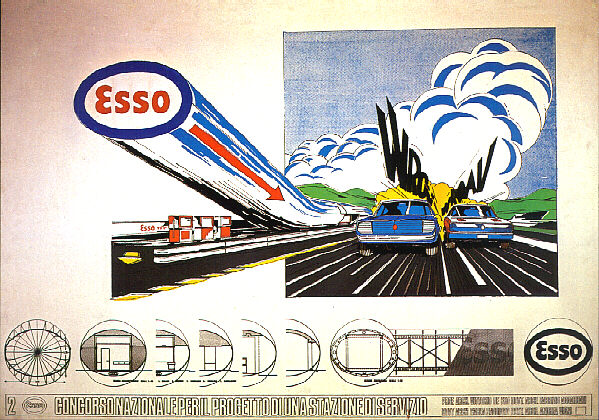
Vittorio De Feo, Fabrizio Aggarbati, Carla Saggioro, Andrea Vigni, Competition Project for a new Service Station, 1971.
2008.08.23 21:06
peter's canon
Personally, I like seeing all the study models of various projects by various architects. I like it because it clearly demonstrates just how pliant architectural designing can be. And I seriously consider the notion that it may well be Gehry that best introduced architectonic pliancy to the profession.
Is architectonic pliancy in somewhat sharp contrast to Eisenman's method? Up to a certain point (in time) I'd say yes. And when Eisenman's work started exhibiting some measure of pliancy, that's where I start to see Gehry's influence.
Have Gehry's designs of late become somewhat predictable and/or seemingly uninspired? Perhaps the pliability metaphor applies here too; perhaps the pliancy has been lost for being stretched too much and too far.
Another thing I like about all the study models is that so often almost any one of the models looks to be an exciting and/or interesting building. And often too it is within the collection of study models that one finds the riskier designs. "Getting it right" isn't the only operation going on. There's also a having-to-let-go of good designs.
2008.08.23 22:55
peter's canon
To suspect that Eisenman's process conceals a much more pliant process doesn't eliminate Gehry's already self-evident very pliant process. Gehry's entire oeuvre is evidence of a very pliant design process.
Has Eisenman really been designing a process? It looks to me more like he's been designing a determinism, and I am personally aware of an aspect of Eisenman's process that proves very inflexible.
2011.08.23 11:20
Ideas
Personally, I see the notion of "architectural idea" as something distinct from "design concept" or "design methodology" or "design ideology" or even "thesis statement". For example, promenade architecturale is an architectural idea, like Le Corbusier's '5 points' are an architectural idea. Mat or box or blob or a combination of all three are architectural ideas. As per inspiration from team 10 primer, 'building as threshold' is an architectural idea.
13082301 Hejduk designs Hejduk derivative design plans 2197i05
13082302 Hejduk designs Hejduk derivative designs Campo Rovine plans 2413i15
13082303 Wave Wall House 2 plans model 2410i03 b
13082304 Bye House Distorted plan model perspectives 2327i02 b
2014.08.23 14:58
22 August
Just received Log 31, and, regarding Campus Martius East, go read Random Memory: The Master of Rugtown and note Orhan Ayyüce's warning:
"Hey Quondam, they need to be made into a real rug. Don't wait until someone rip you off..."
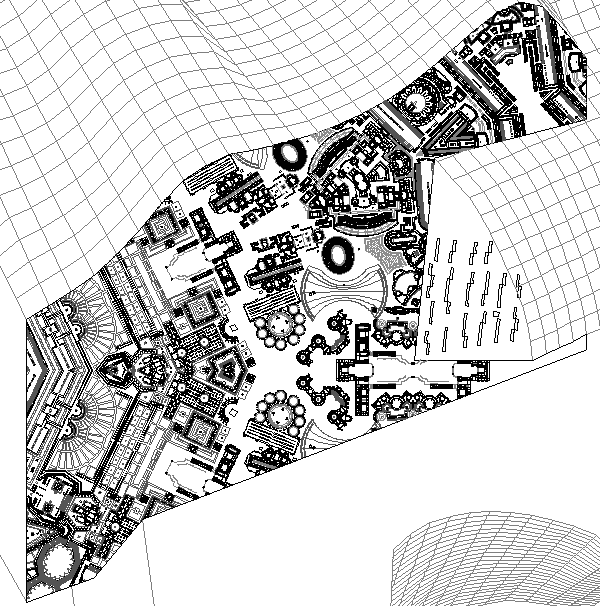
I'm pretty sure 25 April 2013 was when I decided the name of this recently designed section of New Not There City was Karastan. Now look at 27 June 2013!
Instead of going out and buying a bottle of vodka, I decided to buy http://www.architects-copy-quondam.com/ instead. I don't know if I'll actually do anything with it, but it's already making me laugh.
14082301 OMA Fondazione Prada Milan
18082301 City Tower section plan plaza plan 217di04
18082302 City Tower Y2K House Casa da Musica Flick House I plans sections 217di05
18082303 Seagram Building plan working site plan elevation 217xi06
18082401 City Tower Seagram Building Y2K House Casa da Musica Flick House I Flick in Musica Stonehenge Hadrian's Villa Pantheon Analogous Building Palais des Congrès Hurva Synagogue Museum for Nordrhein Westfalen plans elevations sections 217di06
18082301 Smiljan Radic Teatro Regional del BioBío Concepción
19082301 museum collecting Farnsworth House Glass House Eames House Painting Gallery Sculpture Gallery Pond Pavilion Library Maison de l'Homme House 10: Museum Wall House 2 Atheneum plans elevations section site plan 2171i09
19082302 museum collecting @ Johnson Estate Farnsworth House Glass House Eames House Maison de l'Homme House 10: Museum Wall House 2 Atheneum plans elevations section 2171i10
20082301 Mount Pleasant site plan orthagonal 2109i11
21082301 Grotta Residence plans working data 2264i03
| |
2014.08.23 09:44
22 August
I might be getting Log 31 in the mail today. I ordered it at amazon almost two months ago, but for some reason they weren't able to restock it until recently. Thanks for the gesture anyway. Of course, the "focus on contemporary practitioners working openly with history" is of automatic interest to me--Quondam, as a virtual museum of architecture, is by default a contemporary 'practice' openly working with history. But, as Quondam (and its collection) developed, the notion of virtualizing an 'other' history of architecture also developed, and HQ of DATA (above) is a prime example of that. (Plus, there is the ongoing exploitation of the quickness and ease with which architectural graphic data can be manipulated via CAD--in the above case a 'to scale 'photo montage' in 3D'.) I just thought of another notion that might 'explain' some of the workings at Quondam: playing with history at the same scale.
Analogous Building, 1993:
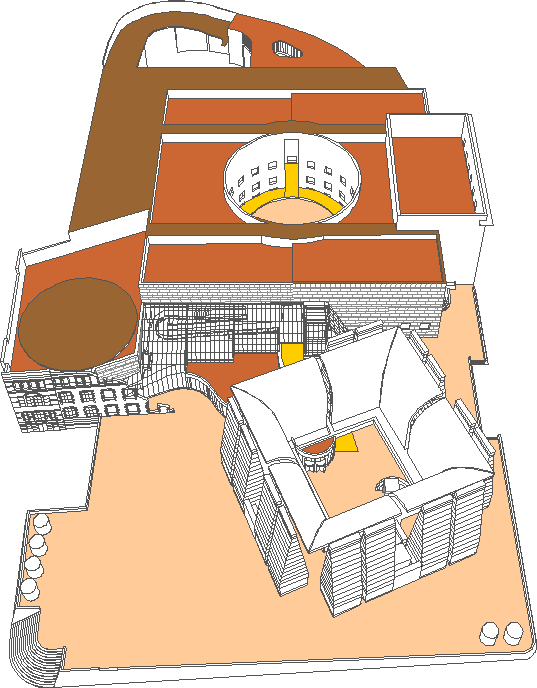
Parthenon columns at Villa Stein de Monzie, 1993:
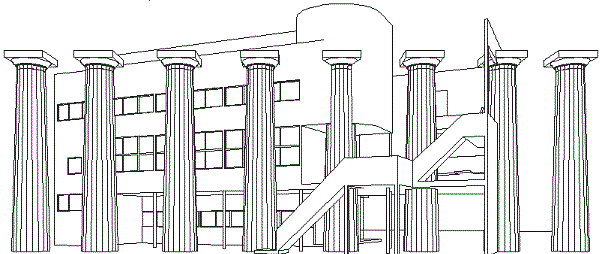
Broken Temple, 1993:
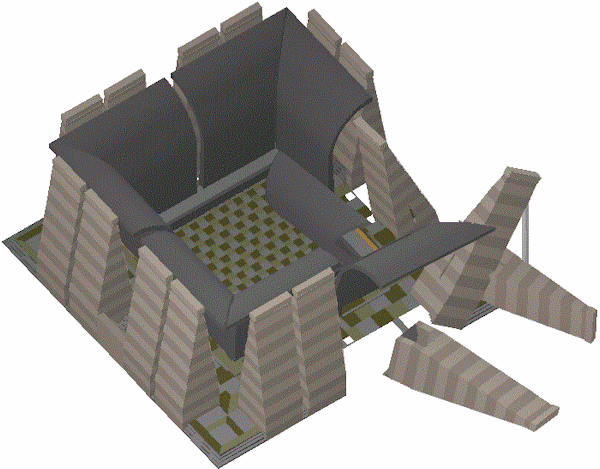
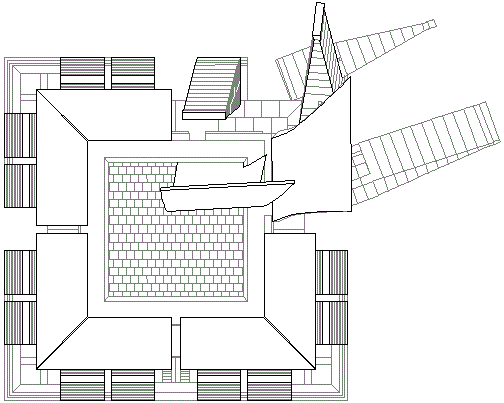
|